 |
WHOA The "Home for Christmas" Crier No. 1
|
 |
 |
WHOA The "Home for Christmas" Crier No. 1
|
 |
| The following is a reproduction
of an original Clark AFB Philippine Flyer, Newsletter #81, describing the
dramatic events leading up to and following the eruption of Mt. Pinatubo.
Photographs have been added from various sources.
Original copy
contributed by Vincent J Slupecki, Wagner HS Class of 1970
|
|
Philippine
Flyer 3
continued
from page 2 |
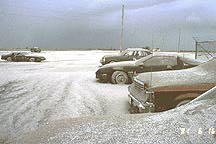
But not for long. Early Sunday morning, a small security recon team made its way back to the base to assess the damage and determine whether or not it was safe for others to return. Based on their report, a command element returned a few hours later, and those folks were followed by more security troops. By nightfall, about 100 ash warriors were back on base. It wasn't pretty, and it wasn't fun. The damage was extensive, and the mountain continued erupting and the earth continued quaking. Buildings had collapsed, power and water were off, roads were impassable except by vehicles with four-wheel drive. Our beautiful base looked to one SP the way he thought a "lunar desert landscape" would look. Still and all, the volcano had taken its best shot at us, and we had survived. Now It was time to begin picking up the pieces. |
|
The Philippine Star reported that Aeta tribesmen believed the volcano -- which they look up to as their god -- erupted because they have neglected their offerings. The tribesmen used to sacrifice a pig to appease the volcano, but lately, due to economic hardship. they began offering chickens. Taken from the June 26 Philippine Flyer |
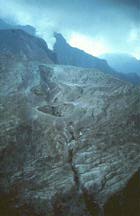 At the same time strong quakes ripped the area until midnight. Sometime during this period, the dome collapsed into the volcano and -- mixed with the magma intruding from beneath -- was blown into the atmosphere. As a result, the new summit -- now a caldera, or crater, about 2 kilometers in diameter -- is l45 meters lower. Of biblical proportion Although it will take time for the experts to determine Pinatubo's place in history, initial measurements indicate it was at least the fourth largest of the century...several times larger than the 1980 eruption of Mount St. Helens in Washington. |
The damage
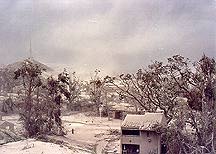
Ash warriors returning to Clark were stunned by what they saw. A solid black wall of ash -- looking for all the world like the edge of night -- hung to the northwest. All around the base stood trees stripped of most of their leaves and branches. Roads and runways were buried under 4-8 inches of ash. Raln-heavy ash and constant quakes collapsed 111 buildings, including the Youth Center, Skate Center, Levln Gym, seven supply warehouses, several hangars, much of the power plant, and all the F4 environmental shelters. Sixty-four other buildings need major repair while 448 more require minor repair or cleanup. Mud flows, or lahars, raced through the base exchange area, destroying the bookstore, damaging the vehicles in the New car Sales lot, and flooding the commissary. Others destroyed the NCO club and covered the grounds of the old Wagner High School with 3 feet of mud. Also, sometime during the eruptions June 15-18, a pyroclastic flow roared down the Sacobia River valley, stopping just 300 yards short of Mactan housing. On top of all this, during the first days back, the mission essential team faced the task of recovering the base without power or running water. |
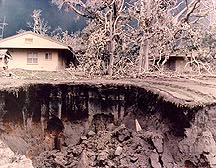 The eruptions haven't stopped and ash still falls most days, but the frequency and intensity are gradually decreasing. Earthquakes continue to roll through the base about 20 times a day -- some even originate under Clark. While most are too small to be felt, occasionally we get a rocker that measures 5.0 on the Rlchter scale. Since the big eruption, our primary concern has been with the threat of mud flows. Ash from piles hundreds of meters deep up on the mountain is washed down every time it rains. Because Clark sits on the high ground between the Sacobia and Abacan Rivers we've avoided the big flows so far. |
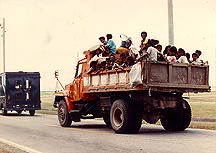
Outside the base, however, lahars have already knocked down the Friendship Bridge, the Bamban Bridge, and the Abacan Bridge on MacArthur Highway. Along the rivers, thousands of homes have been smashed and swept away by the mud. Unfortunately, scientists say this activity -- the eruptions, ash fall, earthquakes and mud flows -- could continue for 10 years. |
|
|
|
|
|
|
|
|
|
|
|